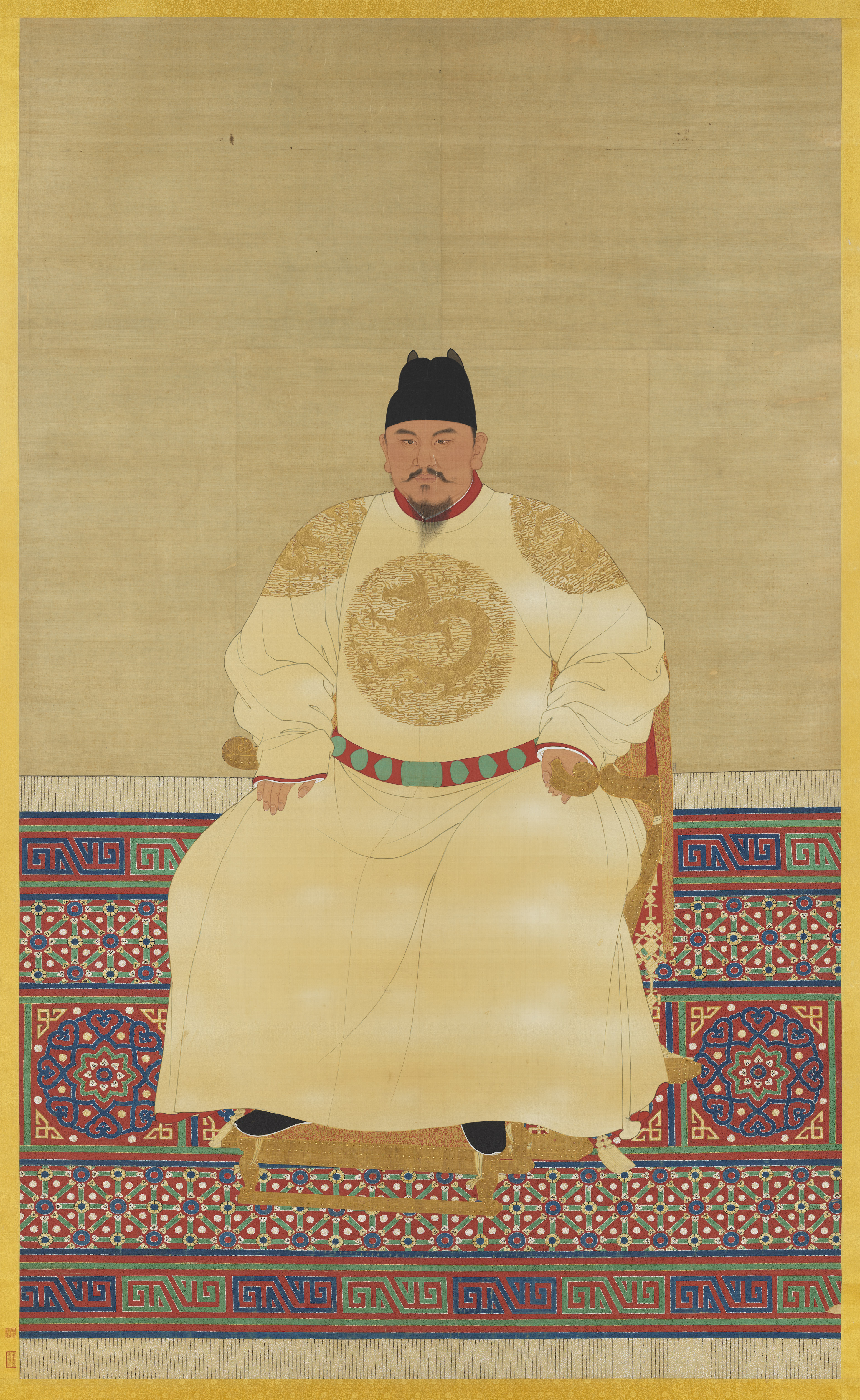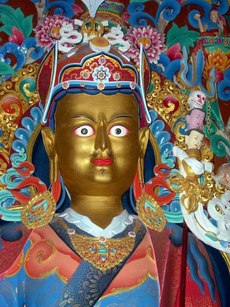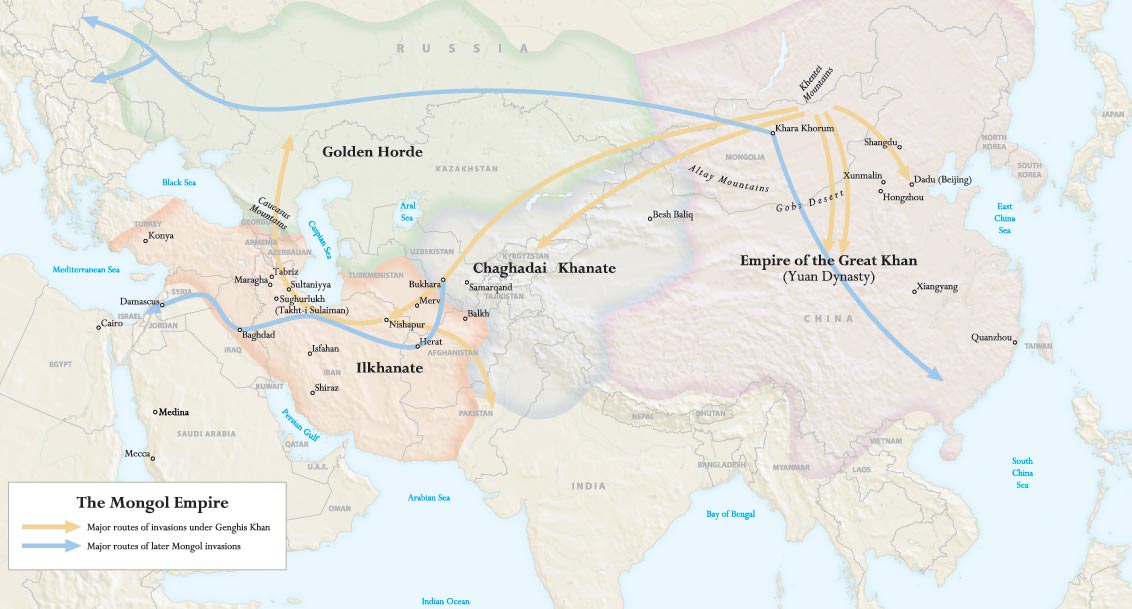|
Imperial Preceptor
The Imperial Preceptor, or Dishi (; ), was a high title and powerful post in the Yuan dynasty. It was created by Kublai Khan as part of Mongol patronage of Tibetan Buddhism and the Yuan administrative rule of Tibet. The title was originally created as the State Preceptor or Guoshi (; ) in 1260, the first year of Kublai Khan's enthronement. In that year he appointed the Sakya lama Drogön Chögyal Phagpa to this post and soon placed him in charge of all Buddhist clergy. In 1264, he founded the Bureau of Buddhist and Tibetan Affairs and appointed Phagpa as the first director of this important new agency. The lama was offered nominal rule over all Tibet and also supervised Mongol relations with the Buddhist clergy. In 1270, Phagpa became Imperial Preceptor (Dishi) when the title was renamed. As Imperial Preceptor, he was authorized to issue letters and proclamations to the temples and institutions of Tibet, and he advised the emperor regarding official appointments in Tibet. Kubl ... [...More Info...] [...Related Items...] OR: [Wikipedia] [Google] [Baidu] [Amazon] |
Yuan Dynasty
The Yuan dynasty ( ; zh, c=元朝, p=Yuáncháo), officially the Great Yuan (; Mongolian language, Mongolian: , , literally 'Great Yuan State'), was a Mongol-led imperial dynasty of China and a successor state to the Mongol Empire after Division of the Mongol Empire, its division. It was established by Kublai (Emperor Shizu or Setsen Khan), the fifth khagan-emperor of the Mongol Empire from the Borjigin clan, and lasted from 1271 to 1368. In Chinese history, the Yuan dynasty followed the Song dynasty and preceded the Ming dynasty. Although Genghis Khan's enthronement as Khagan in 1206 was described in Chinese language, Chinese as the Han Chinese, Han-style title of Emperor of China, Emperor and the Mongol Empire had ruled territories including modern-day northern China for decades, it was not until 1271 that Kublai Khan officially proclaimed the dynasty in the traditional Han style, and the conquest was not complete until 1279 when the Southern Song dynasty was defeated in t ... [...More Info...] [...Related Items...] OR: [Wikipedia] [Google] [Baidu] [Amazon] |
Emperor Of China
Throughout Chinese history, "Emperor" () was the superlative title held by the monarchs of imperial China's various dynasties. In traditional Chinese political theory, the emperor was the " Son of Heaven", an autocrat with the divine mandate to rule all under Heaven. Emperors were worshiped posthumously under an imperial cult. The lineage of emperors descended from a paternal family line constituted a dynasty, and succession in most cases theoretically followed agnatic primogeniture. The emperor of China was an absolute monarch. During the Han dynasty, Confucianism gained sanction as the official political theory. The absolute authority of the emperor came with a variety of governing duties and moral obligations; failure to uphold these was thought to remove the dynasty's Mandate of Heaven and to justify its overthrow. In practice, emperors sometimes avoided the strict rules of succession and dynasties' purported "failures" were detailed in official histories written by ... [...More Info...] [...Related Items...] OR: [Wikipedia] [Google] [Baidu] [Amazon] |
Yeshe Rinchen
Yeshe Rinchen () was a Tibetan Imperial Preceptor (''Dishi'') at the court of the Mongol-led Yuan dynasty. He lived from (1248-1294) and hailed from Sakya, the foremost monastic regime in Tibet in this period, and held the title from 1286 to his dethronement in 1291. Sakya and the Sharpa lineage In the course of the 13th century, the Sakya abbots Sakya Pandita and Phagpa forged a working relationship with the Mongol conquerors, becoming their agents in Tibetan affairs. In 1270, Phagpa was appointed Imperial Preceptor (''Dishi'') by Kublai Khan. This office was not merely religious but also political: the ''Dishi'' exerted a paramount influence in the Bureau of Buddhist and Tibetan Affairs (Xuanzheng Yuan) which was the office that oversaw Buddhist and Tibetan affairs. His decrees bore the same weight as the great khan in Central Tibet. He usually resided close to the Yuan emperor. The first three ''Dishi'' belonged to the Khon lineage, members of which were hereditary abbots of ... [...More Info...] [...Related Items...] OR: [Wikipedia] [Google] [Baidu] [Amazon] |
Dharmapala Raksita
Dharmapala Raksita (), who lived from (1268 – December 1287) was the head of the Sakya school of Tibetan Buddhism, which was the most powerful school in Tibet under the Yuan dynasty from 1280 to 1282. He also held the title of Imperial Preceptor (Dishi), from 1282 to 1286. Background The Mongols had interfered in the political affairs of Tibet since c. 1240, using the senior lamas of the Sakya monastery as middlemen. A Mongol administration was set up in 1268-1269 and a census was taken. Central Tibet was divided into 13 ''trikor'' () or myriarchies. The temporal administrator of Tibet was called ''dpon-chen'' (''ponchen'') and resided in Sakya since about 1264. The abbot-rulers of the Sakya see enjoyed a precedence position, based on their personal ties with the Mongol great khans. This was in particular the case with Drogön Chögyal Phagpa (1235–1280), who also held the position of Imperial Preceptor (Dishi) at the Yuan court. The succeeding Imperial Preceptors always belonge ... [...More Info...] [...Related Items...] OR: [Wikipedia] [Google] [Baidu] [Amazon] |
Rinchen Gyaltsen
Rinchen Gyaltsen () who lived from (1238 – 24 March 1279) was a Tibetan imperial preceptor at the court of the Mongol-led Yuan dynasty of China. His reign lasted from 1274 to his demise in either 1279 or 1282. Family background Rinchen Gyaltsen was born in 1238 as the son of Zangtsa Sonam Gyaltsen and his wife Jomo Dro. His father belonged to the Khon family, members of which were hereditary abbot-rulers of the Sakya Monastery in Tsang in western Tibet. In the time of his uncle, the abbot Sakya Pandita (1182-1251), Sakya became brokers between the various Tibetan petty lords and the Mongol power. Rinchen Gyaltsen's elder half-brother Phagpa enjoyed a close relationship with Kublai Khan and was appointed to the title Imperial Preceptor (''Dishi'') in 1270. As such he was a standing institution in the Yuan government, enjoying extraordinary honours and resources. The ''Dishi'' had a paramount influence on the Bureau of Buddhist and Tibetan Affairs (Zongzhi Yuan, later Xua ... [...More Info...] [...Related Items...] OR: [Wikipedia] [Google] [Baidu] [Amazon] |
Stupa
In Buddhism, a stupa (, ) is a domed hemispherical structure containing several types of sacred relics, including images, statues, metals, and '' śarīra''—the remains of Buddhist monks or nuns. It is used as a place of pilgrimage and meditation. Walking around a stupa in a clockwise direction, known as '' pradakhshina'', has been an important ritual and devotional practice in Buddhism since the earliest times, and stupas always have a ''pradakhshina'' path around them. The original South Asian form is a large solid dome above a tholobate, or drum, with vertical sides, which usually sits on a square base. There is no access to the inside of the structure. In large stupas, there may be walkways for circumambulation on top of the base as well as on the ground below it. Large stupas have, or had, ''vedikā'' railings outside the path around the base, often highly decorated with sculpture, especially at the torana gateways, of which there are usually four. At the top of ... [...More Info...] [...Related Items...] OR: [Wikipedia] [Google] [Baidu] [Amazon] |
Chogyal Phagpa
The Chogyal ("Dharma Kings", ) were the monarchs of the former Kingdom of Sikkim, which belonged to the Namgyal dynasty, . The Chogyal was the absolute monarch of Sikkim from 1642 to 1973, and the constitutional monarch from 1973 to 1975, when the monarchy was abolished and the Sikkimese people voted in a referendum to make Sikkim the 22nd state of India. History From 1642 to 1975, Sikkim was ruled by the Namgyal Monarchy (also called the Chogyal Monarchy), founded by Phuntsog Namgyal, the fifth-generation descendant of Guru Tashi, a prince of the Minyak House who came to Sikkim from the Kham province of Tibet. Chogyal means 'righteous ruler', and was the title conferred upon Sikkim's Buddhist kings during the reign of the Namgyal Monarchy. The reign of the Chogyal was foretold by the patron saint of Sikkim, Guru Rinpoche. The 8th-century saint had predicted the rule of the kings when he arrived in the state. In 1642, Phuntsog Namgyal was crowned as Sikkim's first Chogy ... [...More Info...] [...Related Items...] OR: [Wikipedia] [Google] [Baidu] [Amazon] |
Yuan Empire
The Yuan dynasty ( ; zh, c=元朝, p=Yuáncháo), officially the Great Yuan (; Mongolian language, Mongolian: , , literally 'Great Yuan State'), was a Mongol-led imperial dynasty of China and a successor state to the Mongol Empire after Division of the Mongol Empire, its division. It was established by Kublai (Emperor Shizu or Setsen Khan), the fifth khagan-emperor of the Mongol Empire from the Borjigin clan, and lasted from 1271 to 1368. In Chinese history, the Yuan dynasty followed the Song dynasty and preceded the Ming dynasty. Although Genghis Khan's enthronement as Khagan in 1206 was described in Chinese language, Chinese as the Han Chinese, Han-style title of Emperor of China, Emperor and the Mongol Empire had ruled territories including modern-day northern China for decades, it was not until 1271 that Kublai Khan officially proclaimed the dynasty in the traditional Han style, and the conquest was not complete until 1279 when the Southern Song dynasty was defeated in t ... [...More Info...] [...Related Items...] OR: [Wikipedia] [Google] [Baidu] [Amazon] |
Renzong Emperor
Emperor Renzong of Song (30 May 1010 – 30 April 1063), personal name Zhao Zhen, was the fourth emperor of the Song dynasty, Northern Song dynasty of China. He reigned for about 41 years from 1022 to his death in 1063, making him the longest reigning Song dynasty emperor. He was the sixth son of his predecessor, Emperor Zhenzong, and was succeeded by his cousin's son, Emperor Yingzong of Song, Zhao Shu who took the throne as Emperor Yingzong of Song, Emperor Yingzong because his own sons died prematurely. Early life and ascension to the throne Emperor Renzong's father Emperor Zhenzong died in 1022 leaving the 12 year-old Renzong as the new emperor. His adoptive mother Empress Liu (Zhenzong), Empress Liu acted as the regent before Renzong reached majority. By 1027, Renzong was old enough to rule on his own but Empress Liu (Zhenzong), Liu refused to step down and ruled until her death in 1033. Reign Compared to other renowned Chinese emperors, Emperor Renzong is less well-kno ... [...More Info...] [...Related Items...] OR: [Wikipedia] [Google] [Baidu] [Amazon] |
Sangha
Sangha or saṃgha () is a term meaning "association", "assembly", "company" or "community". In a political context, it was historically used to denote a governing assembly in a republic or a kingdom, and for a long time, it has been used by religious associations, including Buddhists, Jains and Sikhs. Given this history, some Buddhists have stated that the tradition of the ''sangha'' represents humanity's oldest surviving democratic institution. In Buddhism, ''sangha'' refers to the monastic communities of ''bhikkhu'' (monks) and '' bhikkhuni'' (nuns). These communities are traditionally referred to as the ''bhikkhu-sangha'' or the ''bhikkhuni-sangha''. As a separate category, those Buddhists who have attained any of the four stages of enlightenment, whether or not they are members of the monastic community, are referred to as the ''āryasaṅgha'' ("noble Sangha"). According to the Theravada school and Nichiren Shoshu Buddhism, the term ''sangha'' does not refer to ... [...More Info...] [...Related Items...] OR: [Wikipedia] [Google] [Baidu] [Amazon] |
Buddhism
Buddhism, also known as Buddhadharma and Dharmavinaya, is an Indian religion and List of philosophies, philosophical tradition based on Pre-sectarian Buddhism, teachings attributed to the Buddha, a wandering teacher who lived in the 6th or 5th century Before the Common Era, BCE. It is the Major religious groups, world's fourth-largest religion, with about 500 million followers, known as Buddhists, who comprise four percent of the global population. It arose in the eastern Gangetic plain as a movement in the 5th century BCE, and gradually spread throughout much of Asia. Buddhism has subsequently played a major role in Asian culture and spirituality, eventually spreading to Western world, the West in the 20th century. According to tradition, the Buddha instructed his followers in a path of bhavana, development which leads to Enlightenment in Buddhism, awakening and moksha, full liberation from ''Duḥkha, dukkha'' (). He regarded this path as a Middle Way between extremes su ... [...More Info...] [...Related Items...] OR: [Wikipedia] [Google] [Baidu] [Amazon] |
Silk Road
The Silk Road was a network of Asian trade routes active from the second century BCE until the mid-15th century. Spanning over , it played a central role in facilitating economic, cultural, political, and religious interactions between the Eastern world, Eastern and Western worlds. The name "Silk Road" was coined in the late 19th century, but some 20th- and 21st-century historians instead prefer the term Silk Routes, on the grounds that it more accurately describes the intricate web of land and sea routes connecting Central Asia, Central, East Asia, East, South Asia, South, Southeast Asia, Southeast, and West Asia as well as East Africa and Southern Europe. The Silk Road derives its name from the highly lucrative trade of silk textiles that were History of Silk, primarily produced in China. The network began with the expansion of the Han dynasty (202 BCE220 CE) into Central Asia around 114 BCE, through the missions and explorations of the Chinese imperial env ... [...More Info...] [...Related Items...] OR: [Wikipedia] [Google] [Baidu] [Amazon] |






